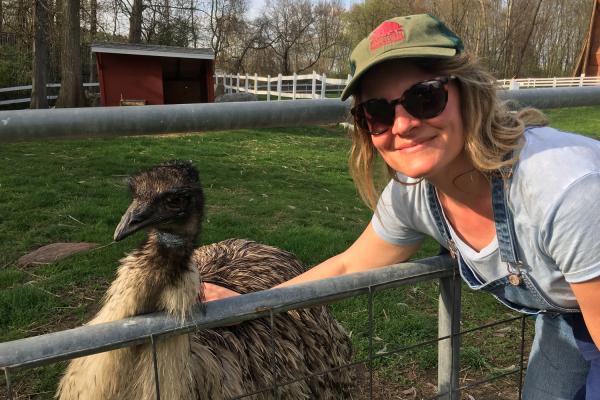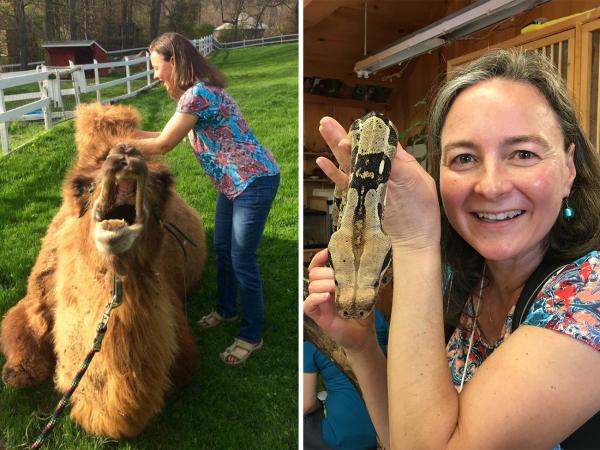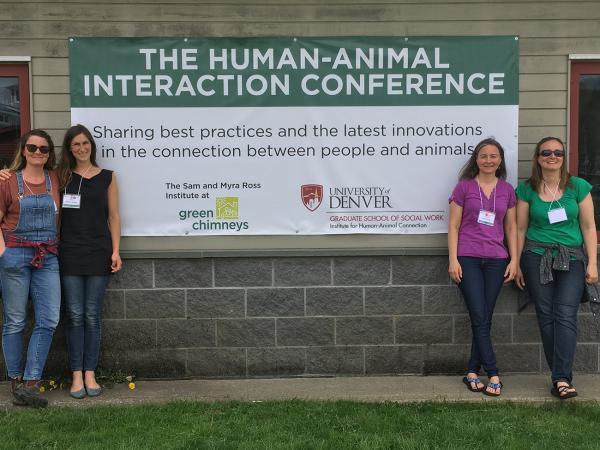I go there every summer - and I just live n Burlington. Whenever I have company I take them there.
International Group Convenes for Learning on ‘Human-Animal Interaction’
It’s not often that year-round farmyard staff take an off-site trip two weeks before opening day! But it was clear that the Human-Animal Interaction Conference taking place on the campus of a large farm-based education center and school (The Farm & Wildlife Center at Green Chimneys in Brewster, New York) would be a worthwhile journey to invigorate our work as the Shelburne Farms season unfolds.
We were right.
Here at the Farm, we know that animals have magic. We see it every day when we introduce the public to our wooly, furry, and feathered friends in the Children’s Farmyard. The conference helped us understand that magic a bit better, and pushed us to consider how we might harness it more to further our programming.
For example, animals can offer considerable health benefits. Pet owners have fewer negative health incidents, including headaches, mood swings, and lower depression rates. While our farm animals aren’t pets, we likewise see their calming effect on visitors and program participants (like 4Hers). Similarly, horses can be used to support mindfulness, and many educators and therapists are finding animals to have an especially positive effect on the social behaviors of children on the autism spectrum.
When working with animals, you have to consider what species--and individual animals--will work best with your audiences. Not everyone appreciates all animals equally, so find the animals that sing for you, then integrate them into your programming.
At Shelburne Farms, chickens have been part of our Children’s Farmyard almost since its beginning. And we see many kids fall head over heels for them (visitors and educators, too). They’re fun! Their dinosaur-like feet are strange, they come in so many shapes, colors, sizes and breeds, and, when handled regularly, they even get pretty friendly. Their eggs and meat also make it easy for visitors to make the farm-to-plate connection. Chickens work for us!With animals as therapy, however, Green Chimneys Farm Director Michael Kauffman has a caution. “It's not always about being successful with [students] every day. Rather it's about meeting them where they are. Sometimes just being with an animal is as important as ‘doing’ something with the animal.”
At Shelburne Farms, we often adopt this approach. We let kids just be with animals, be in a forest, or be in a field. With our Farm culture of learning through play and fostering curiosity through joy, we meet visitors where they are every day. We’re excited that this is a promising practice in farm-based education elsewhere, as well. (Some of our favorite activities for opening the senses and tuning into a place include: handful of sounds, animal observation ethogram, and sit spots!)
Kauffman’s work at the Green Chimneys’ wildlife rehabilitation center offers a perfect metaphor for how students’ lives can be transformed. "We help heal the animals and once they've received all the skills they need, we release them into the world where they can thrive," he told us.We discovered the term for all this work: “humane education.” This is education that emphasizes the three Rs: reverence, respect, and responsibility. Through working with animals, people learn communication, patience, tolerance, and social skills.
“I believe it’s possible to create a just, humane and sustainable world,” plenary speaker Zoe Weil shared. “In 20 years, I want ‘humane education’ to be synonymous with education.” It sounded a lot like our vision for an education system built on the Big Ideas of Sustainability! Weil suggested that our charge as educators is to support children who are developing in all ways to become “solutionaries” - to apply real-world focus, and take action with whole system approaches to the earth’s problems. We fully agreed.
This desire to build places where children can be biologically, psychologically, and socially healthy was common ground for everyone at the conference. Many shared a story of having childhoods that afforded them ample outdoor, farm-based opportunities for work and play. The power of these experiences led them to professions where they could cultivate these experiences for others.Overall, it was amazing to be among these social workers, occupational therapists, psychologists, and animal-assisted intervention specialists who see the profound impact animals have on people, though through different lenses.
See you in the Children’s Farmyard this summer!
The Farm & Wildlife Center at Green Chimneys in Brewster, New York is a special education school, wildlife rehabilitation center, residential treatment center for children, working farm, and site for public programming and events (to name a few)! Like Shelburne Farms, it is incredibly complex, with hundreds of moving parts intricately tied to their mission. We were so grateful to have Green Chimneys as our classroom for two days.
Resources from the Human-Animal Interaction Conference
- Green Chimneys Farm and Wildlife Center
- Institute for Humane Education
- Midwest Center for Trauma and Emotional Healing
- Purdue University Center for the Human-Animal Bond
- Professional Association for Therapeutic Horsemanship International
- University of Denver Institute for Human-Animal Connection
- Waltham Centre for Pet Nutrition




